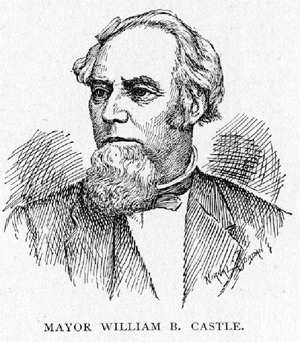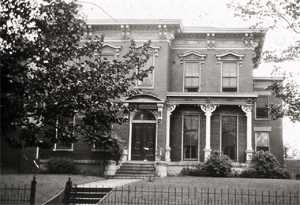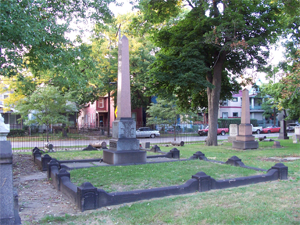William Bainbridge Castle 1814 - 1872
Mary Derby DOD 1837
The Last and First Mayor
The following historical biography can be found in The Encyclopedia of Cleveland History
“Castle, William Bainbridge (November 30, 1814 – February 28, 1872) a businessman and mayor, was born in Essex, Vermont, moved to Toronto in 1815 and settled in Cleveland in 1827 (one source indicates 1832). Later that year, Castle, his father, and Charles Giddings opened Cleveland’s first lumberyard. Upon his father’s death (either 1829 or 1832), Castle returned to Ontario, moving to Ohio City in 1839 and in 1840 forming the hardware partnership of Castle & Field. Castle joined the Cuyahoga Steam Furnace Company as an accountant in 1843, became manager in 1859, and was with the company until his death.
For many years Castle was a member of the Ohio City Common Council and was mayor in 1853-1854, when he helped write the 1854 agreement merging Ohio City into Cleveland. Upon consolidation, Castle resigned as mayor, but was elected in 1855 as mayor of Cleveland, when he directed cutting a shorter channel between Lake Erie and the Cuyahoga, opening the river to larger ships; and building a suitable harbor on the lakefront. He promoted and became a trustee of the city’s waterworks, which began in 1856. Castle was defeated for reelection in 1857.
Castle was a director of the finance boards of the People’s Gas & Light Company, the Citizen’s Savings & Loan Company and various railroads. Castle married twice. In 1836, he married Mary Derby who died a year later. In 1840, he married Mary Newell; the Castles had 1 son and 3 daughters.”

The following biography was taken from Cleveland Past and Present, Its Reprentative Men, Comprising Biographical Sketches of Pioneer Settlers and Prominent Citizens With a History of the City and Historical Sketches of Its Commerce, Manufactures, Ship Building, Railroads, Telegraphy, Schools, Churches, Etc., by Maurice Joblin, published 1869.
William B. Castle was born in Essex, Crittenden county, Vermont, November 30, 1814. Immediately on the conclusion of the war, his father removed to Toronto, where he had been engaged, as an architect, to superintend the construction of the first Parliament buildings there. In 1827, he removed with his family to Cleveland, William B. Castle being then thirteen years old. His father had taken a farm about thirteen miles from the city, and there the lad spent most of his time until 1832, when, in company with his father and Mr. Charles M. Giddings, he established the first lumberyard in Cleveland. The business was carried on for a couple of years, when Mr. Castle, Sr., died, and the son removed to Canada, engaging in merchandizing and in manufacturing lumber for the yard in Cleveland. In 1839, he abandoned the Canada branch of the business, and in the following year the partnership with Mr. Giddings was dissolved.
A new partnership was formed with a brother-in-law, under the name of Castle & Field, for carrying on the hardware, in connection with jewelry and watch making, business, on the west side of the river, then known as Ohio City. In 1843, he left the business and entered the Cuyahoga Steam Furnace Company, with which he has ever since been connected. So thoroughly identified has Mr. Castle been with the history of that establishment during the past quarter of a century, that this is a fitting place for a brief sketch of the nature and history of the pioneer iron company of Cleveland.
In 1830, Mr. Charles Hoyt projected the works which were erected and put in operation under the firm name of Hoyt, Railey & Co. In 1834, the firm was changed to an incorporated company under the name of the Cuyahoga Steam Furnace Company, with a capital of one hundred thousand dollars, of which three-fourths were paid in. The principal stockholders at the time of the incorporation were Josiah Barber, Richard Lord, John W. Allen, and Charles Hoyt. The managing officer was Charles Hoyt. Soon after the incorporation the works were burned to the ground, but the company were energetic, and soon a substantial brick structure, two hundred and thirty-five feet front, with a wing of ninety feet deep, was erected on the site of the destroyed building. The pig metal for the use of the works was obtained at the company's blast furnace at Dover, twelve miles west, and was considered equal in quality to the best Scotch pig. In 1840, Mr. Hoyt was succeeded in the management by D. Cushing, who had been secretary of the company. In 1843, Mr. Cushing gave place to Elisha T. Sterling, who remained the head of the concern until his untimely death, in 1859.
From the advent of Mr. Sterling and the consequent re-organization of the staff of officers of the works, dates the connection of Mr. Castle with the establishment. Mr. Castle took the position of secretary, and held that post until the death of Mr. Sterling, when he was appointed to fill the position of manager. At the time when the sole charge of the works devolved upon him the company was in a deplorable financial condition. The prospect was sufficient to daunt a less resolute and hopeful spirit, but Mr. Castle at once set about the Herculean task of bringing the concern through its difficulties and establishing it on a firm financial basis. The struggle was long continued, and more than once the advance gained seemed suddenly to be again lost, but eventually it was pulled through without having compromised a single debt, and without having but a single case of litigation under his management. This case was not properly chargable to the administration of the works, as it arose from the supplying of a defective beam strap, which, there being then no forges in Cleveland, had been ordered from Pittsburgh. This unusual exemption from litigation was, doubtless, owing to the invariable rule adopted by Mr. Castle, to reduce all contracts to careful writing and to live strictly up to the letter as well as spirit of the contract.
The heavy work of the establishment in its early years was the supplying of most of the mills in Ohio and the new States of the West with mill gearing, and the manufacture of agricultural implements. In 1840, was commenced the manufacture of stationary and land steam engines. In 1843, the manufacture of marine engines was commenced by building the engine for the first propeller on Lake Erie, the "Emigrant." About the same time work was commenced on engines for the large side-wheel steamers, the largest of their day being fitted out with machinery from these works. Among the steamers thus equipped, and which were in their successive days them wonders of the lakes, was the Europe, Saratoga, Hendrick Hudson, Pacific, Avon, and Ohio. Among the propellers receiving their engines from the Cuyahoga Works were the Winslow, Idaho, Dean Richmond, Ironsides, S. D. Caldwell, Meteor, and a very large number of others, besides a great many first-class steam tugs plying on Detroit river.
In 1853, the introduction of the manufacture of locomotives added a new feature to the manufacturing industry of Cleveland. The Cleveland, Columbus and Cincinnati Railroad was supplied from these works, and locomotives were also made for the Cleveland and Pittsburgh, Lake Shore, Cleveland and Toledo, and Bellefontaine and Indianapolis Railroads, besides several other railroads in the west. In 1857, this branch of the business was sold out to the Cleveland, Columbus and Cincinnati Railroad Company, who now use the locomotive works for the manufacture and repair of their own engines.
In addition to the marine engines, for which the establishment has become famous, the company have lately entered upon the manufacture of first class engines and blowing machines for blast furnaces. These have been supplied to the furnaces in the Mahoning Valley and Wisconsin, and to furnaces elsewhere, even supplying Pittsburgh, the home of the iron manufacture. A very large engine has been constructed for the Atlantic Docks, in Brooklyn, New York. Rolling mill engines and machinery have been made for mills at Alliance, in the Tuscarawas Valley, at Harmony, Indiana, and at Escanaba, in the Lake Superior iron district. Various engines have been supplied to the Newburgh works, including the blowing engines and hydraulic cranes for the Bessemer steel works, among the most perfect of their kind in America. Railway tools manufactured by the company's works have been ordered from so far east as New Jersey.
The Cuyahoga Steam Furnace Company have employed at times two hundred and fifty men, and will probably average one hundred and fifty. Year after year the company have been compelled to enlarge their facilities, until now their property occupies the two corners of Detroit and Centre streets, and one corner of Centre and West River streets. The buildings extend three hundred and fifty feet on the river, and to a greater length on Detroit street. The capital employed amounts to about a quarter of a million dollars. The importance of these works in attracting attention and capital to Cleveland, in giving employment to the people, and in assisting to build up the business of the city, can hardly be overestimated. Taking its nature, extent and history together it may probably be said with safety that nothing in the city has had a more important influence in shaping the future of Cleveland and contributing to its present prosperity, and much of this influence is due to the labor and wisdom of Mr. Castle. At present the works are organized under the presidency of Mr. Castle, with Josephus Holloway as superintendant and designing engineer; S. J. Lewis, secretary; W. W. Castle, book-keeper. From 1843 to 1857, the superintendent and designing engineer, was Mr. Ethan Rogers, who by his knowledge and skill added very much to the celebrity of the works.
In 1853, Mr. Castle was elected mayor of Ohio City, and during his term of office the consolidation of the two cities was effected. To bring about this desirable end he labored diligently, and was one of the commissioners for settling the terms of annexation. In 1855, he was elected mayor of the Consolidated city, and his rule was marked by vigor, justice, and a strict regard for the rights and interests of the citizens. For six years subsequent to his mayoralty he held the office of commissioner of water works.
Mr. Castle was married in December, 1836, to Miss Mary Derby, who died in Canada in the following year. In 1840, he was married to Miss Mary H. Newell, of Vermont, by whom he has had one son and three daughters. The son, W. W. Castle, now twenty-six, is book-keeper of the Cuyahoga Steam Furnace Company. The oldest daughter is wife of Mr. Robert R. Rhodes, of Cleveland. The youngest daughters are still at school.
The success of Mr. Castle has been achieved by a persistent struggle against adverse circumstances and with but little to aid him but a resolute will and good constitution. At an early age he was left with the care of his father's family on his hands, and has had to fight, not only his own battles, but to struggle with the difficulties into which circumstances had thrown the company with which he became connected. Out of the struggle he has come with a spotless reputation, the esteem of his friends and the respect of his fellow-citizens, financial prosperity, and the blessing of good health and undiminished vigor.
The following historical description can be found in The Encyclopedia of Cleveland History:
The Cuyahoga Steam Furnace Company was the first iron manufacturer in the Cleveland area. Chas. Hoyt started the company in the Cuyahoga valley in 1827 at Center and Detroit Streets in Brooklyn Township. It was the first shop to utilize steam power in the region. On 3 Mar. 1834, it became Cleveland’s first incorporated manufacturing plant. Soon afterward a fire swept the shop, and a larger plant was erected, producing over 500 tons of castings annually and employing up to 100 workers. Cuyahoga Steam Furnace grew by adapting to the region’s changing needs for metal forms. Originally it produced mill gearings; with the increase in lake traffic, Cuyahoga moved by 1843 into the marine engine field. By 1849 the firm had no debts and had become the state’s largest producer of steam engines. It then ventured into locomotive construction, building the first locomotive west of the Alleghenies in 1849. With a growing locomotive business, the company erected a substantial plant near the old shop in 1853. By 1857, the plant had produced 100 locomotives, with $60,000 in annual sales. Due to the panic of 1857 it decided to close its locomotive works and return to safer, more profitable lines of work at its Detroit Street plant. During the Civil War it was a large supplier of railroad iron to the Union forces. Cuyahoga maintained its business for the next 20 years, until it was purchased by the Cleveland Ship Building Company, the forerunner of the American Ship Building Company in 1887.
Cemetery records show that William Castle's body was disinterred from Monroe on September 17, 1888 and moved to Lake View Cemetery with Mary D., George N., and Mary F. Castle. The removal record from 1888 incorrectly states that he was moved to Riverside. His original burial information notes that it was Lake View. There's also a large monument for him at that cemetery.

